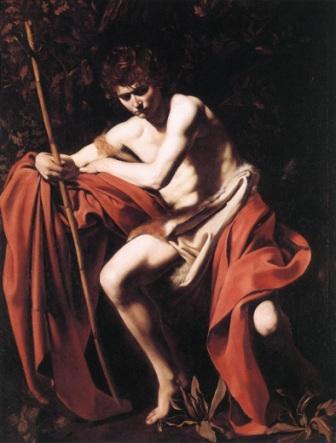A slight, brooding young man slumps over a rock in a darkened wood. He’s naked, but for a spare stretch of an animal’s skin thrown lazily over his lap. A single, improbable beam of light pierces the gloom and brings life to his creamy skin and wiry frame. His weary expression suggests an awareness of the cruel fate awaiting him.
The ode to male beauty described above is actually the famous portrait St John the Baptist in the Wilderness by the 16th-century master Michelangelo Merisi da Caravaggio, and it is currently on display at the National Gallery of Canada in Ottawa as part of a major new exhibit of Caravaggio’s works and those of his imitators.
The exhibit is the first of its kind – Caravaggio’s work has never been presented in Canada, and such a large collection of his surviving works has never been presented at once.
Caravaggio’s work, with its stark realism and dramatic, emotional subject matter, helped to launch modern painting. Using real-life models to portray saints and religious figures that had previously been depicted as superhuman made his subjects seem suddenly accessible.
His work frequently glamorized masculinity. He presented young men with more exposed flesh than was probably necessary, making his work controversial in its time. He painted street toughs dressed for duels with their weapons drawn or at the ready.
That Caravaggio painted mostly men in his career is not wholly surprising, given that the public sphere of the Rome he lived in was dominated largely by men. But the way he handled his subject matter was also influenced by his sexuality.
“The idea of Caravaggio as a gay or bisexual man has been with us for a couple of generations now,” says Christopher Etheridge, curator of European art at the Gallery. “There are some hints from his time, but we’re not sure how much is valid. We don’t have any conclusive evidence.”
Homosexual encounters were fairly common in Renaissance and post-Renaissance Rome and Florence, and Caravaggio is known to have associated with Rome’s seedier elements. He frequently painted subjects from the city’s underbelly, including gamblers and gypsy fortune-tellers. In fact, his models most likely came from those seedy elements and may have been prostitutes themselves.
One of Caravaggio’s major innovations was to paint from real life, bringing real humanity to his subjects. His work spawned imitators throughout Europe, many of whom are on display in the Gallery.
In the same room as Caravaggio’s St John the Baptist are a collection of similarly composed religious and mythical male nudes painted in a distinctively modern style.
“This room is to make you think of how flesh can be made expressive,” Etheridge explains.
He points to a painting of Orpheus by Dutch painter Gerrit van Honthorst. It’s composed similarly to Caravaggio’s St John and includes even more modern touches. Unlike classical portrayals of mythical figures, Orpheus is shown posed with domestic animals, wearing a modern mustache and playing an anachronistic modern violin. Again, the eye is drawn to the figure of a slender young man, nude but for a strip of red cloth hiding his groin.
Caravaggio broke down the wall between high art and everyday life. He and his followers launched a movement that overturned Europe’s artistic conventions. Whether or not Caravaggio was gay himself may be immaterial when his work leaves us with so much to enjoy on its own.
A vid from the ngcmedia YouTube channel…


 Why you can trust Xtra
Why you can trust Xtra


